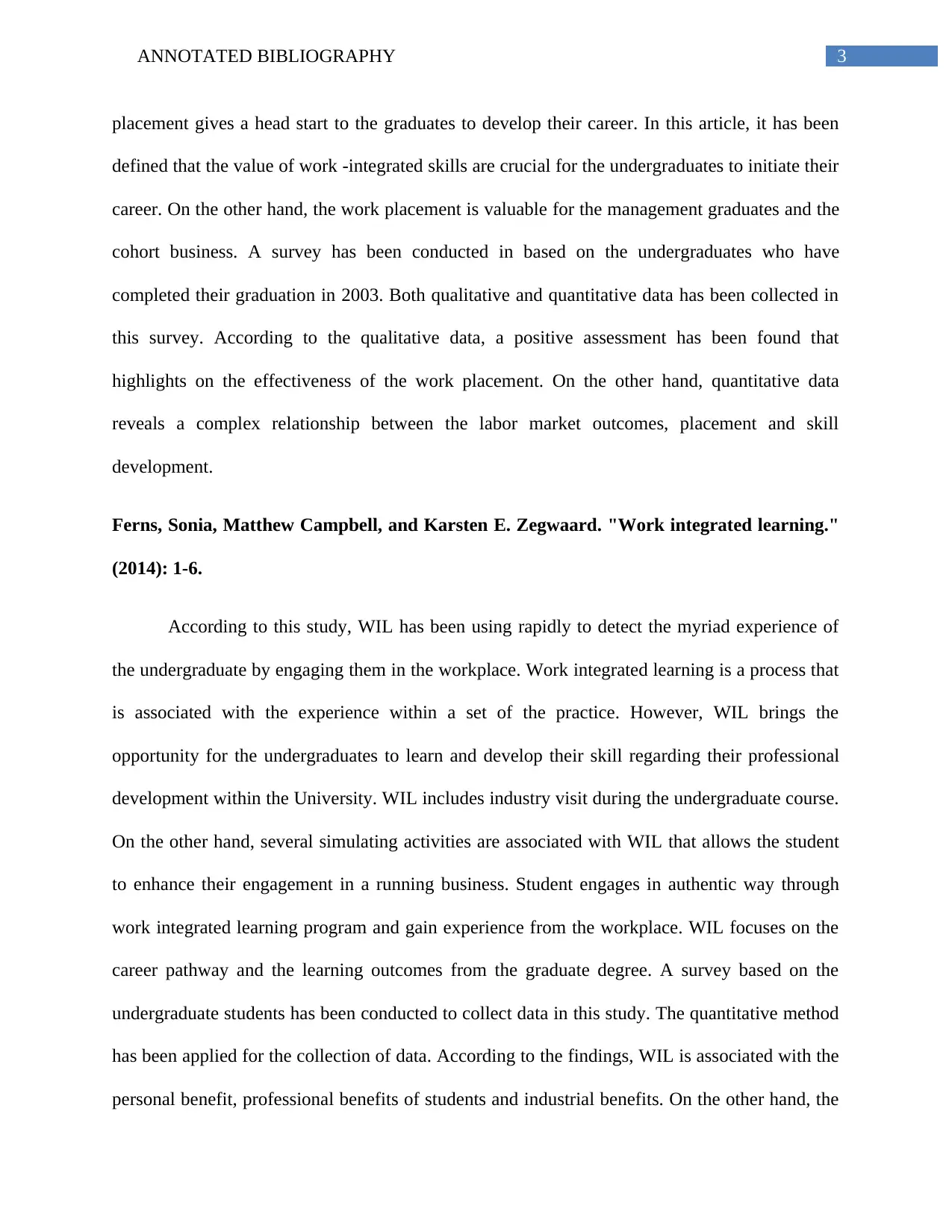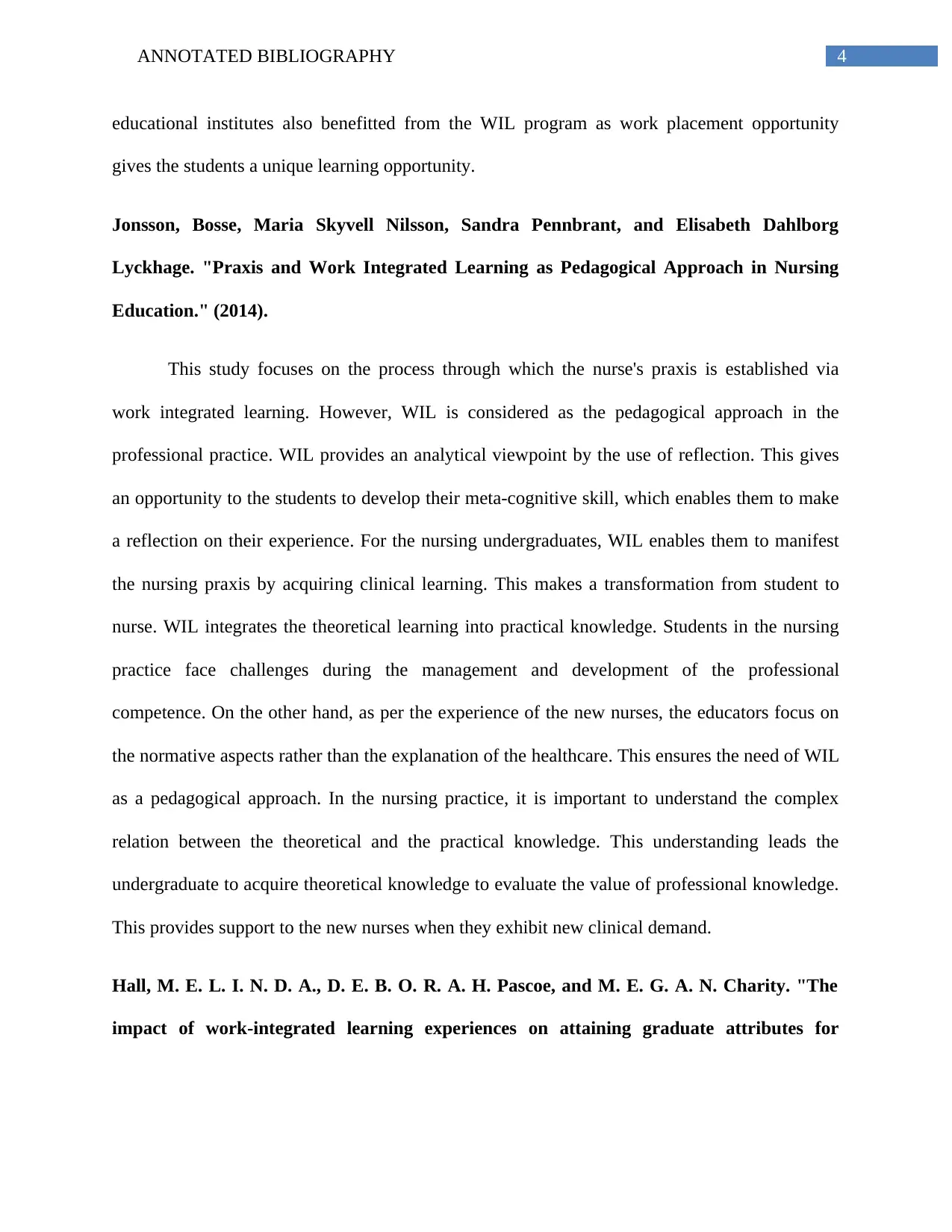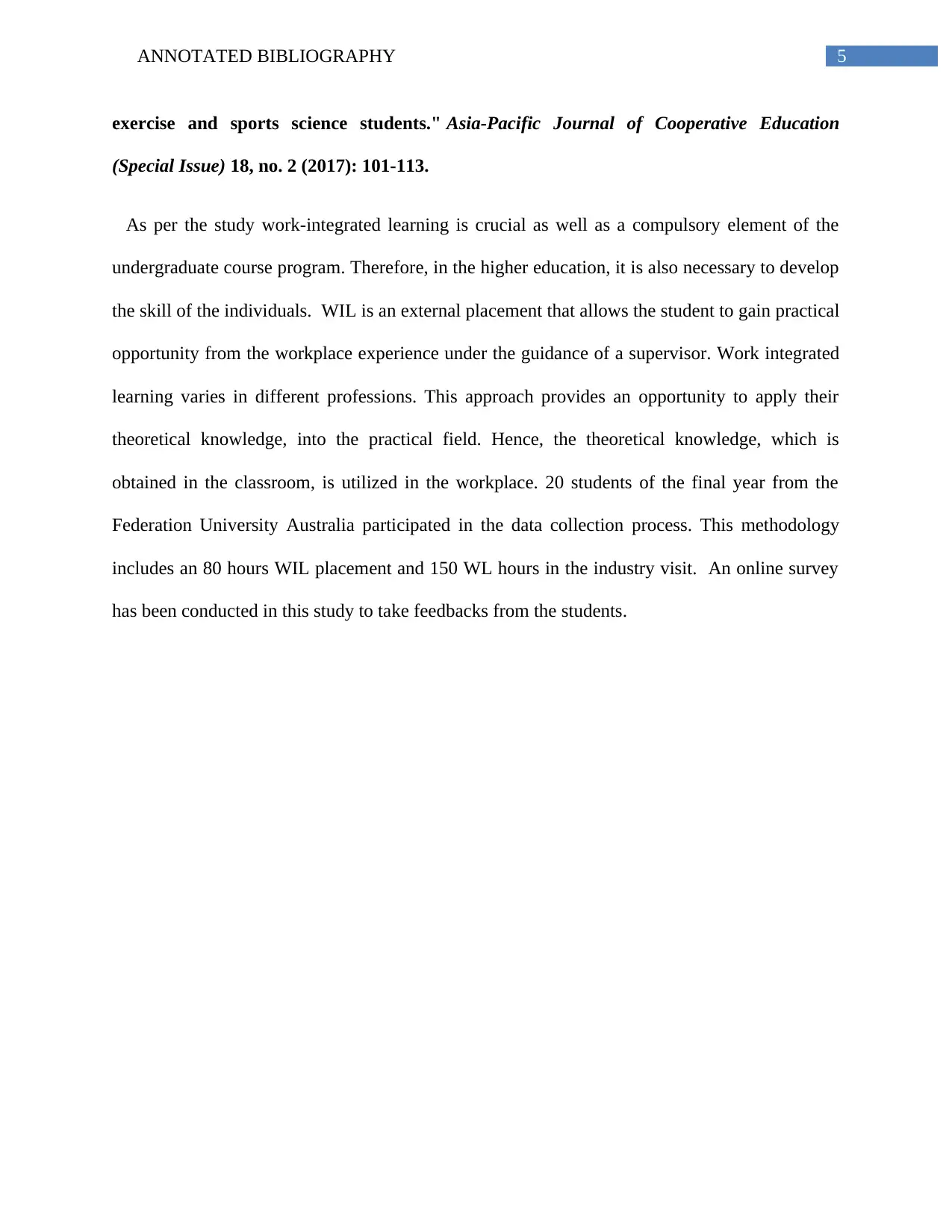Annotated Bibliography on Work-Integrated Learning for Employability
VerifiedAdded on 2019/10/31
|6
|1393
|311
Annotated Bibliography
AI Summary
This annotated bibliography provides an overview of several studies related to work-integrated learning (WIL) in higher education. The studies explore the benefits of WIL in developing employability skills, enhancing career outcomes, and providing practical experience for students. Jackson's study examines the barriers and best practices of WIL, while Wilton's research focuses on the impact of work placements on business and management graduates. Ferns, Campbell, and Zegwaard discuss the broader application of WIL, and Jonsson et al. explore its use in nursing education. Hall et al. investigate the impact of WIL on exercise and sports science students. The bibliography highlights the importance of WIL in bridging the gap between theoretical knowledge and practical application, emphasizing its role in preparing students for the workforce and enhancing their professional development. The studies use various methodologies, including surveys and data analysis, to assess the effectiveness of WIL programs and identify factors that influence student outcomes. The overall theme emphasizes the importance of WIL in higher education to ensure that graduates are well-prepared for their future careers.

Running head: ANNOTATED BIBLIOGRAPHY
Annotated Bibliography
Name of the Student:
Name of the University:
Author’s Note:
Annotated Bibliography
Name of the Student:
Name of the University:
Author’s Note:
Paraphrase This Document
Need a fresh take? Get an instant paraphrase of this document with our AI Paraphraser

2ANNOTATED BIBLIOGRAPHY
Jackson, Denise. "Employability skill development in work-integrated learning: Barriers
and best practice." Studies in Higher Education 40, no. 2 (2015): 350-367.
According to this study, a clear idea has been got about the work integrated learning and
its importance in the undergraduate degree. However, the work integrated learning processes to
equip the new graduates and it has been using widely. It has been found that the new graduates
with the knowledge of work-integrated learning can perform effectively in the working
environment. From the evaluation of the work, integrated learning or WIL program the process
of WIL has been addressed in the context of the students. In this study, there is an account of the
best practices that use in the classrooms in order to develop the employability skills. On the other
hand, several factors influence the performance of individuals during WIL. According to this
study, a survey has been conducted to collect data. 31 undergraduates of Australian University
with different discipline are selected as the participants during this survey. In this survey, the
experience of the students during the placement and their feelings about what is crucial for their
learning are listed. These are aligned with the vital principles of WIL program. Apart from this
problem while performing the certain skill also identified during the survey.
Wilton, Nick. "The impact of work placements on skills development and career outcomes
for business and management graduates." Studies in Higher Education 37, no. 5 (2012):
603-620.
The above study reveals that development of the graduate employability is helpful for the
economic contribution in the higher education. This undergraduate employability skill has two
benefits one focuses that the placement of the work provides a positive environment through
which an undergraduate develops generic employability skills. The second benefit focuses that
Jackson, Denise. "Employability skill development in work-integrated learning: Barriers
and best practice." Studies in Higher Education 40, no. 2 (2015): 350-367.
According to this study, a clear idea has been got about the work integrated learning and
its importance in the undergraduate degree. However, the work integrated learning processes to
equip the new graduates and it has been using widely. It has been found that the new graduates
with the knowledge of work-integrated learning can perform effectively in the working
environment. From the evaluation of the work, integrated learning or WIL program the process
of WIL has been addressed in the context of the students. In this study, there is an account of the
best practices that use in the classrooms in order to develop the employability skills. On the other
hand, several factors influence the performance of individuals during WIL. According to this
study, a survey has been conducted to collect data. 31 undergraduates of Australian University
with different discipline are selected as the participants during this survey. In this survey, the
experience of the students during the placement and their feelings about what is crucial for their
learning are listed. These are aligned with the vital principles of WIL program. Apart from this
problem while performing the certain skill also identified during the survey.
Wilton, Nick. "The impact of work placements on skills development and career outcomes
for business and management graduates." Studies in Higher Education 37, no. 5 (2012):
603-620.
The above study reveals that development of the graduate employability is helpful for the
economic contribution in the higher education. This undergraduate employability skill has two
benefits one focuses that the placement of the work provides a positive environment through
which an undergraduate develops generic employability skills. The second benefit focuses that

3ANNOTATED BIBLIOGRAPHY
placement gives a head start to the graduates to develop their career. In this article, it has been
defined that the value of work -integrated skills are crucial for the undergraduates to initiate their
career. On the other hand, the work placement is valuable for the management graduates and the
cohort business. A survey has been conducted in based on the undergraduates who have
completed their graduation in 2003. Both qualitative and quantitative data has been collected in
this survey. According to the qualitative data, a positive assessment has been found that
highlights on the effectiveness of the work placement. On the other hand, quantitative data
reveals a complex relationship between the labor market outcomes, placement and skill
development.
Ferns, Sonia, Matthew Campbell, and Karsten E. Zegwaard. "Work integrated learning."
(2014): 1-6.
According to this study, WIL has been using rapidly to detect the myriad experience of
the undergraduate by engaging them in the workplace. Work integrated learning is a process that
is associated with the experience within a set of the practice. However, WIL brings the
opportunity for the undergraduates to learn and develop their skill regarding their professional
development within the University. WIL includes industry visit during the undergraduate course.
On the other hand, several simulating activities are associated with WIL that allows the student
to enhance their engagement in a running business. Student engages in authentic way through
work integrated learning program and gain experience from the workplace. WIL focuses on the
career pathway and the learning outcomes from the graduate degree. A survey based on the
undergraduate students has been conducted to collect data in this study. The quantitative method
has been applied for the collection of data. According to the findings, WIL is associated with the
personal benefit, professional benefits of students and industrial benefits. On the other hand, the
placement gives a head start to the graduates to develop their career. In this article, it has been
defined that the value of work -integrated skills are crucial for the undergraduates to initiate their
career. On the other hand, the work placement is valuable for the management graduates and the
cohort business. A survey has been conducted in based on the undergraduates who have
completed their graduation in 2003. Both qualitative and quantitative data has been collected in
this survey. According to the qualitative data, a positive assessment has been found that
highlights on the effectiveness of the work placement. On the other hand, quantitative data
reveals a complex relationship between the labor market outcomes, placement and skill
development.
Ferns, Sonia, Matthew Campbell, and Karsten E. Zegwaard. "Work integrated learning."
(2014): 1-6.
According to this study, WIL has been using rapidly to detect the myriad experience of
the undergraduate by engaging them in the workplace. Work integrated learning is a process that
is associated with the experience within a set of the practice. However, WIL brings the
opportunity for the undergraduates to learn and develop their skill regarding their professional
development within the University. WIL includes industry visit during the undergraduate course.
On the other hand, several simulating activities are associated with WIL that allows the student
to enhance their engagement in a running business. Student engages in authentic way through
work integrated learning program and gain experience from the workplace. WIL focuses on the
career pathway and the learning outcomes from the graduate degree. A survey based on the
undergraduate students has been conducted to collect data in this study. The quantitative method
has been applied for the collection of data. According to the findings, WIL is associated with the
personal benefit, professional benefits of students and industrial benefits. On the other hand, the
⊘ This is a preview!⊘
Do you want full access?
Subscribe today to unlock all pages.

Trusted by 1+ million students worldwide

4ANNOTATED BIBLIOGRAPHY
educational institutes also benefitted from the WIL program as work placement opportunity
gives the students a unique learning opportunity.
Jonsson, Bosse, Maria Skyvell Nilsson, Sandra Pennbrant, and Elisabeth Dahlborg
Lyckhage. "Praxis and Work Integrated Learning as Pedagogical Approach in Nursing
Education." (2014).
This study focuses on the process through which the nurse's praxis is established via
work integrated learning. However, WIL is considered as the pedagogical approach in the
professional practice. WIL provides an analytical viewpoint by the use of reflection. This gives
an opportunity to the students to develop their meta-cognitive skill, which enables them to make
a reflection on their experience. For the nursing undergraduates, WIL enables them to manifest
the nursing praxis by acquiring clinical learning. This makes a transformation from student to
nurse. WIL integrates the theoretical learning into practical knowledge. Students in the nursing
practice face challenges during the management and development of the professional
competence. On the other hand, as per the experience of the new nurses, the educators focus on
the normative aspects rather than the explanation of the healthcare. This ensures the need of WIL
as a pedagogical approach. In the nursing practice, it is important to understand the complex
relation between the theoretical and the practical knowledge. This understanding leads the
undergraduate to acquire theoretical knowledge to evaluate the value of professional knowledge.
This provides support to the new nurses when they exhibit new clinical demand.
Hall, M. E. L. I. N. D. A., D. E. B. O. R. A. H. Pascoe, and M. E. G. A. N. Charity. "The
impact of work-integrated learning experiences on attaining graduate attributes for
educational institutes also benefitted from the WIL program as work placement opportunity
gives the students a unique learning opportunity.
Jonsson, Bosse, Maria Skyvell Nilsson, Sandra Pennbrant, and Elisabeth Dahlborg
Lyckhage. "Praxis and Work Integrated Learning as Pedagogical Approach in Nursing
Education." (2014).
This study focuses on the process through which the nurse's praxis is established via
work integrated learning. However, WIL is considered as the pedagogical approach in the
professional practice. WIL provides an analytical viewpoint by the use of reflection. This gives
an opportunity to the students to develop their meta-cognitive skill, which enables them to make
a reflection on their experience. For the nursing undergraduates, WIL enables them to manifest
the nursing praxis by acquiring clinical learning. This makes a transformation from student to
nurse. WIL integrates the theoretical learning into practical knowledge. Students in the nursing
practice face challenges during the management and development of the professional
competence. On the other hand, as per the experience of the new nurses, the educators focus on
the normative aspects rather than the explanation of the healthcare. This ensures the need of WIL
as a pedagogical approach. In the nursing practice, it is important to understand the complex
relation between the theoretical and the practical knowledge. This understanding leads the
undergraduate to acquire theoretical knowledge to evaluate the value of professional knowledge.
This provides support to the new nurses when they exhibit new clinical demand.
Hall, M. E. L. I. N. D. A., D. E. B. O. R. A. H. Pascoe, and M. E. G. A. N. Charity. "The
impact of work-integrated learning experiences on attaining graduate attributes for
Paraphrase This Document
Need a fresh take? Get an instant paraphrase of this document with our AI Paraphraser

5ANNOTATED BIBLIOGRAPHY
exercise and sports science students." Asia-Pacific Journal of Cooperative Education
(Special Issue) 18, no. 2 (2017): 101-113.
As per the study work-integrated learning is crucial as well as a compulsory element of the
undergraduate course program. Therefore, in the higher education, it is also necessary to develop
the skill of the individuals. WIL is an external placement that allows the student to gain practical
opportunity from the workplace experience under the guidance of a supervisor. Work integrated
learning varies in different professions. This approach provides an opportunity to apply their
theoretical knowledge, into the practical field. Hence, the theoretical knowledge, which is
obtained in the classroom, is utilized in the workplace. 20 students of the final year from the
Federation University Australia participated in the data collection process. This methodology
includes an 80 hours WIL placement and 150 WL hours in the industry visit. An online survey
has been conducted in this study to take feedbacks from the students.
exercise and sports science students." Asia-Pacific Journal of Cooperative Education
(Special Issue) 18, no. 2 (2017): 101-113.
As per the study work-integrated learning is crucial as well as a compulsory element of the
undergraduate course program. Therefore, in the higher education, it is also necessary to develop
the skill of the individuals. WIL is an external placement that allows the student to gain practical
opportunity from the workplace experience under the guidance of a supervisor. Work integrated
learning varies in different professions. This approach provides an opportunity to apply their
theoretical knowledge, into the practical field. Hence, the theoretical knowledge, which is
obtained in the classroom, is utilized in the workplace. 20 students of the final year from the
Federation University Australia participated in the data collection process. This methodology
includes an 80 hours WIL placement and 150 WL hours in the industry visit. An online survey
has been conducted in this study to take feedbacks from the students.

6ANNOTATED BIBLIOGRAPHY
References
Ferns, Sonia, Matthew Campbell, and Karsten E. Zegwaard. "Work integrated learning." (2014):
1-6.
Hall, M. E. L. I. N. D. A., D. E. B. O. R. A. H. Pascoe, and M. E. G. A. N. Charity. "The impact
of work-integrated learning experiences on attaining graduate attributes for exercise and sports
science students." Asia-Pacific Journal of Cooperative Education (Special Issue) 18, no. 2
(2017): 101-113.
Jackson, Denise. "Employability skill development in work-integrated learning: Barriers and best
practice." Studies in Higher Education 40, no. 2 (2015): 350-367.
Jonsson, Bosse, Maria Skyvell Nilsson, Sandra Pennbrant, and Elisabeth Dahlborg Lyckhage.
"Praxis and Work Integrated Learning as Pedagogical Approach in Nursing Education." (2014).
Wilton, Nick. "The impact of work placements on skills development and career outcomes for
business and management graduates." Studies in Higher Education 37, no. 5 (2012): 603-620.
References
Ferns, Sonia, Matthew Campbell, and Karsten E. Zegwaard. "Work integrated learning." (2014):
1-6.
Hall, M. E. L. I. N. D. A., D. E. B. O. R. A. H. Pascoe, and M. E. G. A. N. Charity. "The impact
of work-integrated learning experiences on attaining graduate attributes for exercise and sports
science students." Asia-Pacific Journal of Cooperative Education (Special Issue) 18, no. 2
(2017): 101-113.
Jackson, Denise. "Employability skill development in work-integrated learning: Barriers and best
practice." Studies in Higher Education 40, no. 2 (2015): 350-367.
Jonsson, Bosse, Maria Skyvell Nilsson, Sandra Pennbrant, and Elisabeth Dahlborg Lyckhage.
"Praxis and Work Integrated Learning as Pedagogical Approach in Nursing Education." (2014).
Wilton, Nick. "The impact of work placements on skills development and career outcomes for
business and management graduates." Studies in Higher Education 37, no. 5 (2012): 603-620.
⊘ This is a preview!⊘
Do you want full access?
Subscribe today to unlock all pages.

Trusted by 1+ million students worldwide
1 out of 6
Related Documents
Your All-in-One AI-Powered Toolkit for Academic Success.
+13062052269
info@desklib.com
Available 24*7 on WhatsApp / Email
![[object Object]](/_next/static/media/star-bottom.7253800d.svg)
Unlock your academic potential
Copyright © 2020–2025 A2Z Services. All Rights Reserved. Developed and managed by ZUCOL.





